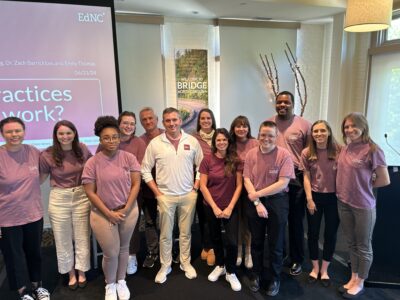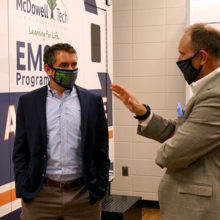It is time for our politicians, policymakers, and philanthropists to head to our hills. It is time for them to meet the people who live in our hollers, drive our highways, and harvest our crops. it is time for them to think about regional strategies that will build a better North Carolina.
Across North Carolina, President-Elect Donald Trump won 76 of our 100 counties. In 23 counties, he won more than 70 percent of the vote: Alexander, Alleghany, Ashe, Avery, Caldwell, Camden, Carteret, Cherokee, Clay, Currituck, Davidson, Davie, Graham, Lincoln, McDowell, Mitchell, Randolph, Rutherford, Stanly, Stokes, Surry, Wilkes, and Yadkin.
Overwhelmingly those counties were in the western part of North Carolina — my “neck of the woods” as my parents might say. I consider Lenoir my hometown, the county seat of Caldwell, and I was born in Morganton, the county seat of Burke.
I have told folks that if they want to experience the real-life version of Hillbilly Elegy — a book by J.D. Vance on his own upbringing in the Appalachian hills — then they should consider coming home with me for a weekend. As my friend, and food scholar, Sheri Castle noted at the Carolina Food Summit, “mountain folk” had to be tough and hardy. As she noted during her storytelling session, she learned from a young age on the family farm that some things in life would be out of her control. So did I.
Adverse childhood experiences
One aspect of rural, impoverished experience that Vance illustrated in Elegy, and one of the more important portions of the book in my view, was Vance’s discussion of Adverse Childhood Experiences (ACEs) and their impact on life.
Vance spoke to the reality that ACEs are not just represented by physical trauma, but that they go far deeper. As the most recent Public School Forum Study Group report illustrated, ACEs include feeling a lack of support from your family, having parents who are divorced, living with a person who is addicted to drugs or alcohol, living with a parent that has attempted suicide, and so much more. ACEs are also driven by environmental factors, such as residing within a violent neighborhood.
Vance wrote about the widespread nature of ACEs:
“A report by the Wisconsin Children’s Trust Fund showed that among those with a college degree or more (the non-working class), fewer than half had experienced an ACE. Among the working class, well over half had at least one ACE, while about 40 percent had multiple ACEs. This is really striking—four in every ten working class-people had faced multiple instances of childhood trauma. For the non-working class, that number was 29 percent.
“I gave a quiz to Aunt Wee, Uncle Dan, Lindsay, and Usha that psychologists use to measure the number of ACEs a person has faced. Aunt Wee scored a seven—higher even than Lindsay and me, who each scored a six. Dan and Usha—the two people whose families seemed nice to the point of oddity—each scored a zero. The weird people where the ones who hadn’t faced any childhood trauma.”
Vance went on to speak to the long-term health studies that have shown that ACEs can even alter the chemistry of the brain. He spoke to the fight-or-flight response that our committee brought up as part of the Public School Forum Study Group, and he went on to speak to the instability of working class families while he illustrated his own families’ struggles.
Inspired by Vance, I took the ACE Quiz for myself. I scored a 5. My sister, Jordan, also scored a 5. My cousin, Lisa, scored a 2.
As I read Elegy, and more recently as I reflected on the election results and the stark differences between rural and urban results across North Carolina, I was reminded of the differences between many of my peers who grew up in prosperous Wake County and my own lived experience.
The instability that Vance speaks of in his family was also represented in my family. I lived for portions of time with my biological parents, my great-grandmother, my great aunt and uncle, my grandmother, and back to my great Aunt and uncle who would later become my legal guardians. I experienced a great deal of instability that undoubtably impacts me even still.
And I was not unique.
The Unifour region
The Unifour region of North Carolina (comprised of Alexander, Burke, Caldwell, and Catawba County) has faced a steady economic decline for my entire life.
The region was once the home of furniture titans such as Broyhill, Bernhardt, and Kincaid. Their factories hummed with activity nearly 24 hours a day. Transfer trucks roared up and down Highway 321 taking furniture to the entire world. Entire industries sprung up to support the furniture factories.
And then in the 1980s the region began to face turbulence as the homegrown companies sold to multi-nationals. This was combined with a massive agricultural crisis that also hollowed out the surrounding farm land. But the decline seemed slow to me.
In November of 1992, the average unemployment rate across the Unifour counties was 4.47 percent compared to 5.8 percent statewide. By 1996, it was 3.2 percent compared to 3.9 percent. In 2004, I left for UNC Chapel Hill and the unemployment rate stood at 6.25 percent that November compared to 5.3 percent statewide. In November of 2010, when experts believe the recession was hitting North Carolina the hardest, the unemployment rate stood at 12.75 percent in the Unifour compared to 10.5 percent statewide. By November of 2012, it was 9.65 percent compared to 8.7 percent.
I’ve told anyone who will listen that to understand the working class voters that carried Trump to victory that they must read not just Hillbilly Elegy, but also Factory Man by Beth Macy, which speaks to the history of Bassett Furniture, the towns it powered, and the family that made the decisions. It could also be a stand-in for the story of Lenoir where I am from. Factory Man begins to explain what happens to a community when the jobs go away and many of them fail to ever return.
Our stressed communities
ACEs are not tied simply to poverty. They are tied to instability, environmental factors, and stressed communities. They have a clear impact on educational outcomes, while also impacting long-term health.
As the jobs faded throughout my childhood, I heard more frequently of divorce. I saw parents of my friends arrested for drug abuse and then I watched as they lost their businesses as a result. I listened to the optimism of my friends and classmates fade as different paths closed off to them.
My community was stressed. It still is.
I can remember our friends sitting around and speaking of our “dying town” and how different it was from the community that our parents spoke about when they spoke of their childhood.
We all struggled to understand what needed to be done to turn the community around.
My friends and family that remain are still wrestling with that question.
White America
As The Atlantic described when they declared in one headline last year, “Middle-Aged White Americans Are Dying of Despair.”
They pinpointed a study that revealed:
“Since 1998, people all over the world have been living healthier and living longer. But middle-aged, white non-Hispanics in the United States have been getting sicker and dying in greater numbers. The trend is being driven primarily by people with a high-school degree or less.”
The early results from the election show that President-Elect Trump won the white working class by 40 points. ProPublica spent a substantial amount of time in Dayton, Ohio to explore the election through the eyes of the white working class.
While there, they found Tracie St. Martin.
As ProPublica shared:
(St. Martin) came from a staunch Democratic family and had voted for Barack Obama in 2008, before not voting in 2012 because, she said, she was away on one of her long-term jobs. She was a single mother with three grown daughters.
“I wanted people like me to be cared about. People don’t realize there’s nothing without a blue-collar worker.” She regretted that she did not have a deeper grasp of public affairs. “No one that’s voting knows all the facts,” she said. “It’s a shame. They keep us so…busy and poor that we don’t have the time.”
I could have taken ProPublica to Lenoir and introduced them to any number of people like St. Martin.
Our future
As my people drive past hollowed out factories that used to buzz with activity, they wish for stable employment, stable communities, and a future that looks bright for their children.
Instead, ACEs are on the rise in schools across the region. Principal Dale Colwell, who leads my alma mater Hibriten High School told me when I visited last December how ACEs were increasing. They were seeing more families in distress. One of the most obvious examples was a rise in the free and reduced-price lunch population from slightly above 34 percent to more than 54 percent in only five years.
Their future and the future of our state won’t be determined by this election. It will be determined by the daily decisions that will be made by our politicians, policymakers, philanthropists, and citizens who are writing our story collectively.
Recommended reading




